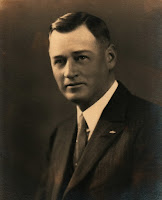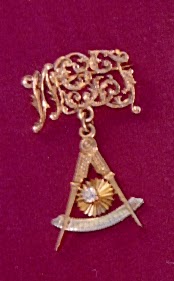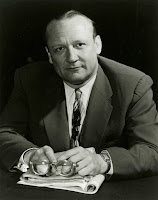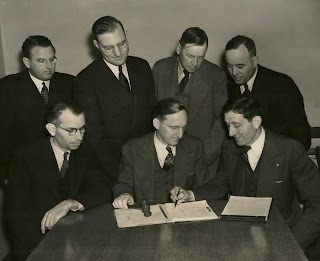 |
| Will Thornally Jr. |
Will got
involved in civic affairs as a young man and continued to be very actively
engaged in public service throughout his life. His civic activities began on
April 9, 1901 when, at the age of 26, he was elected as a trustee for the
Fruitvale Fire Department. At that time fire protection was provided by
volunteers who lived in the community.
The Oakland
Tribune reported on August 2, 1907 that Will was Sargent-at-arms of the Bridge
Club - an organization supporting W.B. Bridge for judge in the Fruitvale
District. Bridge had been a school trustee and had two schools built in
Fruitvale. As a county supervisor he was known for being “an aggressive worker
for public betterment”.
(reference: “Greater
Oakland” by E. Blake)
 |
| Historic photo of the Fruitvale fire station from Google |
On September
3, 1903 Will was a member of a jury that sentenced Victor Walkirez, an African
American man who murdered Elizabeth Leroy, to life in prison. This was a
high-profile and controversial case of the times – many felt the defendant
deserved the death penalty but one juror believed Walkirez was insane when he
committed the murder, so after two weeks and three ballots the jury agreed on a
sentence of life in prison.
Will’s
life-long involvement with the Free
Masons began in 1903 when he was 28. On December 23rd he was
installed as a Junior Warden of the Fruitvale Lodge of
Masons. The news clip from his election provided the following information: "Fruitvale Lodge of Masons installed the following new officers last
night: Worshipful Master, Andrew Frost; Senior Warden, Hugh Frazer; Junior Warden,
William G. Thornally; Secretary, Henry Tyack; Treasurer, P. H. Blake Sr.;
Senior Deacon, E. Spence de Pue; Junior Deacon, Cornelius Carew; Marshal.
George E. Lund; Senior Steward, Arthur P. Snow; Junior Steward, Charles Hughes;
Tyler (sp.), John McArthur.” San
Francisco Call, Dec. 23, 1903.
 |
An architectural detail of the Mason symbol on the
Fruitvale Scottish Rite building built by Will. |
I’ve tried to learn more about Will’s
involvement with the Masons without success. I toured the Masonic Temple around
2008 and was told that they were happy to share historic information about
their members. Twice I have reached out to the Masons and provided them written
background material on William Sr., Will Jr, Harry and John Thornally who were
all members, but I’ve received no response. I do know from other news articles
that Will continued as a Free Mason and rose in their ranks – more on that
below.
The Fruitvale
Board of Trade appointed Will to the organizing committee on June 6, 1904. At
their first meeting they were making plans to send delegates to the statewide
trade convention in Sacramento. The Board of Trade was a civic organization
similar to the Chamber of Commerce or Rotary. That news piece read as follows:
“The spirit of progress is abroad in all of the different
communities on the eastern Bay Shore. District organizations for advancement of
the county at large and sections in particular are being formed where none have
existed before, and old ones are being resurrected into new life. The people of
that delightful section known as Fruitvale are the latest to organize for the
development of a district that has many natural advantages and needs but to be
advertised to be appreciated. The Board of Trade of Fruitvale has been formed,
with Adolph Lorsbach as president……” San Francisco Call, June 6, 1904
On
June 9, 1904 the following news item appeared in the Oakland Tribune. I am not
sure what it means.
“At the
conclusion of the 2nd meeting of the Fruitvale Board of Trade W.G. Thornally
presented the board with a unique emblem in the shape of a substantial
hammer to be used in hammering down and exterminating jointly and
individually all knockers found on the streets of Fruitvale or vicinity. The
gift was accepted and placed in a conspicuous place. 10 new members were taken
into the organization. The meeting was then adjourned until next Thursday.” Oakland Tribune, June 9, 1904 p. 8
Will
was appointed Deputy Constable by Constable Thomas Carroll on July 27, 1904
when he was 29 years old. His appointment came about after two other constables
were dismissed after engaging in a battle with two burglars who were trying to
rob the Sather Station. This was reported in the San Francisco Call.
On
March 6, 1905 the Tribune reported that Will was running for a clerk position
on the Melrose Sanitary District board. His father was the Sanitary Inspector
for Fruitvale from 1903 to 1910. Melrose was another community similar to
Fruitvale. Eventually both were annexed into Oakland.
On
January 17, 1906 the Tribune ran a story headlined “Worshipful Master W.G.
Thornally”. The story was about the planned construction of a Mason Building in
Fruitvale. The headline suggests that Will was now a leader in the Oakland
Masons. Another news piece published in August of 1906 reported that Will was a
candidate to be a delegate to the Republican County Convention representing the
15th District of Oakland. The article did not say if he was elected.
 |
Will's Worshipful Master pin
from the Masons |
In
January of 1910, Will was on the executive committee of the Eastside
Improvement Club of Greater Oakland. The club's mission was to advocate for
"trade at home, adequate fire and police protection in the outlying
sections, better lighting facilities, reasonable street improvements and just
and able representation on the City Council”. In July of that year he, and a
group of men, founded the Young Republican Club – a group that would endorse
and support candidates for office. Will was selected as the first club
President.
CLUB ORGANIZED BY FRUITVALE YOUNG MEN
Young Republicans in Annexed District Form New Alliance
OAKLAND, July 12.— With an initial membership of 280, the Young
Men's republican club of the annexed district has been organized in Fruitvale
with the following officers: William Thornally Jr., President; Bill- Hackett,
First Vice President: George Zimmerman, Second Vice President; M. E. Jacobsen,
Secretary and treasurer. An executive
committee, "composed of Hackett, Zimmerman, T. Rossi, William McKeon and
Edward Lemieux, was also appointed. The new political organization will meet every
Friday night in Lund's Hall, above the Fruitvale post office, until the
election in November. Candidates will be invited to address the club at each
meeting. No candidates will be endorsed until a few days before the election. San Francisco Call,
July 13, 1910.
A year later, on March 11, 1911 a Tribune article identified William G. Thornally as
president of the Representation Club of Greater Oakland. I suspect this was the
same club begun in 1910 with a new name because the story was about their
meeting to endorse Peter C. Frederickson – a candidate for Commissioner of
Oakland. Harry Thornally was also mentioned in the article as being a member of
the executive committee. The Tribune ran a full page political ad for a few days
in May of 1911 that was paid for by the Oakland Progressive Club. It listed
the names of all who were endorsing Frederickson. William Thornally Sr. was
among the group.
The Native
Sons of the Golden West was another active organization in Oakland at this
time. According to Wikipedia, “The Native Sons of the Golden West is a
fraternal service organization founded in 1875, limited to native born
Californians and dedicated to historic preservation, documentation of historic
structures and places in the state, the placement of historic plaques and other
charitable functions within California.” In February of 1912, they were planning a
street fair and carnival that was to be held in Fruitvale. Will was mentioned
in a news clip and identified as a member of the finance committee for the fair.
The event was planned for April 29th to May 4th and would take place on the
Derby property located between Fruitvale Avenue, E. 14th Street, East 12th
Street and Sausal Creek.
1912 was an
exceptional year for Will. He was 37 years old and made the news frequently. In
my research I found several articles about his myriad civic activities. It is
also the year his company built the Saint Joseph’s Home – an entire campus of
impressive brick buildings that still exists today. See the following post
about Will’s professional life.
 |
Will and Agnus with sons Ralph (standing) and George. From Ralph
Thornally's collection. |
In July of
1912, the Representation club hosted a barbeque to promote candidates. The
event was hosted by Mayor Frank C. Mott. He and several others spoke including
State Assemblyman Frank M. Smith. The event took place at Leona Heights and
consisted of “athletic events, speeches and general merry making” according to
the news report. Will was part of the committee that planned the event.
Also
in July of 1912, Will signed a petition as Vice President of an anti-recall group.
The group was planning an event to support Mayor Frank Mott. It was to be held
in conjunction with a suffrage event at MacDonough Theater. The news article
summarized all that had been accomplished under Mott's leadership, including
construction of the 12th Street dam that created Lake Merritt. About 100 years latter my firm help lead an
effort to reconfigure 12th Street which I renamed Lake Merritt
Boulevard on our illustrative drawing. The name stuck and it is now known as
such.
William
J. (sic) Thornally Jr. was one of a very long list of Oakland residents that
signed a petition against the recall of Mayor Frank Mott and two City
commissioners. The Industrial Workers of the World or I.W.W. had mounted a
recall campaign as part of their advocacy for workers to take over their work
places “using any means possible”. This would have been a very controversial
issue of the day. The headline read: “Solid Citizens of Oakland Out With An
Appeal” and the story began …
“OAKLAND, Aug. 2.—A final statement to the men and women who
believe in good government and the triumph of law over disorder and anarchy was
issued today by the Citizens' Municipal Committee. Attention is called to the
pernicious doctrines of the I. W. W., who are the prime movers in this recall
election which has been instituted against Mayor Frank K. Mott and
Commissioners F. C. Turner and W. J. Baccus. ……
The statement is as follows: TO THE CITIZENS OF OAKLAND: On August
5. 1912 There will be held in this city a recall election initiated by members
of an organization known as the Industrial Workers of the World, and commonly
known as the I. W. W. The pretended justification of this election is to recall
certain officials of the city of Oakland, and elect their successors. The real
object, however, is to demonstrate to the people of Oakland and to the country
that the I. W. W. and their sympathizers control the city of Oakland and cannot
be interfered with, no matter what they may say or do.
"The question for you to decide is before you, and as you have
determined so must you cast your ballots. You may vote for the recall of the
mayor and two commissioners because they enforced the law of the city that
prevents the use of vulgarity and profanity in the public streets. You may vote
against law and order and the right of the police department to enforce the
laws on the city statute books. "On the other hand, you can vote against the
recall and to retain the city officials who put a stop to the vile and filthy
attacks that were being made on all forms of religion, decency, public morality
and the flag of the nation. You can enlist under the stars and stripes or under
the red flag of anarchy."
As one of
Oakland’s business and civic leaders Will signed the petition and was actively
engaged in opposing the I.W.W.
 |
| William Knowland |
In
August of 1912, William was elected as a Vice President of the newly created
Knowland Club. The purpose of the club was to get William F. Knowland
re-elected to congress. Knowland was the son of Joseph R. Knowland – publisher
of the
The Oakland Tribune and as
such probably the most powerful man in Oakland. William F. Knowland was
appointed to the United States Congress in 1945 to fill a vacancy created when
Hiram Johnson died. He served in the US Senate until 1959. Previously he was a
California Assemblyman from 1933-35 and a state senator from 1935-39. In the
1950s Knowland was considered as a possible running mate for then President
Dwight D. Eisenhower’s second term.
The
1914 directory listed Will as Vice President of the General Contractors
Association of Alameda County.
 |
A group of business men from Ralph Thornally's collectioin.
Will Thornally back row 3rd from the left. |
Ten
years later in August of 1924, Will announced the start of construction of a
new building that would house the California Builders Exchange and noted that
California was the only such group to own their own building. The cost to build
the building was $150,000. This announcement was made at a barbeque held at the
newly constructed sanatorium in Livermore – built by Will’s company.
Will’s
obituary noted that he was a member of the Sequoyah Country Club and the East
Bay Breakfast Club. His niece Lottie Thornally was grateful that her uncle Will
arranged for her wedding reception to be held at the Sequoyah Club. The
Breakfast Club still exists today.
 |
| One of the buildings on the Sequoyah Country Club campus |
The
obit also noted that Will was a member of the Aahmes Shriners – a group
associated with the Masons. Today, this group of Shriners is still active and is
now located in Livermore. Their website tells us that, “The earliest records
show that the idea for a Shrine Temple in the East Bay first materialized
around 1907. The Shriners Imperial Council granted the charter on July 12, 1911
with the name Aahmes, which means "the moon is born.” The Aahmes Shriners
Temple was first located in Oakland in a series of temporary locations until
the organization purchased a property known as the Defenders Club at 13th and
Harrison Streets. The first meeting was held in that Temple in April 1920.” The Shriners' official philanthropy is their Shriners
Hospitals for Children including a 22-hospital pediatric healthcare system
specializing in orthopedics, burn injuries, spinal cord injuries, cleft palate
surgery, and medical research.
 |
| Interior shot of the Sequoyah Country Club |
So,
in summary Will was a member and leader in the following groups:
Aahmes
Shriner, member
California
Builders Exchange, Vice President and President
Deputy
Constable for Fruitvale
East
Bay Breakfast Club, member
Eastside
Improvement Club, member of the executive committee
Free
Masons, Junior Warden, Worshipful Master
Fruitvale
Board of Trade, member of the Organizing Committee
Fruitvale
Fire Department, Trustee
General
Contractors Association of Alameda County, Vice President
Knowland
Club, Vice President
Native
Sons of the Golden West, finance committee member
Oakland
Builders Exchange, President
Oakland
Progressive Club, member
Representation
Club of Greater Oakland, President
Republican
County Convention, delegate candidate
Sequoia
Country Club, member
W.B
Bridge Club, Sargent-at-Arms
I
too have chosen to be involved with a number of civic and professional groups
and know from experience that each demands time and commitment. For every event
that was reported it is likely that Will attended numerous meetings and spent
hours planning and preparing for these events. Like Will I own a business in
Oakland but I have three business partners that help me manage and operate that
business. Will had a business partner very early in his career but mostly we
worked independently and with great success. Clearly, Will played a key role in
helping Oakland become a great City – he was a leader and a builder. I admire
his efforts and accomplishments and know that my mother held him in very high
regard. The post that follows this one describes the buildings that Will’s
company built in Oakland, Alameda and in other nearby cities.
 |
"Cheaper Gas Aids Builders, 22 May 1938". Will, President
of the Builder's Exchange, on left |
Will’s
wife Agnus died in 1934 when he was 59. After her death he continued to live in
their home on Paramount Road in Oakland but by 1940 he had moved to Berkeley
and was living in a nice Mediterranean-style apartment building at 1700 LeRoy
Street.
Will
died on February 16, 1944 from a heart attack. The newspaper reported that he
collapsed on the sidewalk at 15th and Franklin, very near my office
which is on 17th between Broadway and Franklin. He was taken to
Highland Hospital where he died. At the time of his death he was living at 377
Lenox Avenue in Oakland. The funeral was held at the Clarence N. Cooper
Mortuary and Chapel at 15th and Fruitvale Avenue. Will was buried
with his wife Agnus at Mountain View Cemetery in Oakland.



















